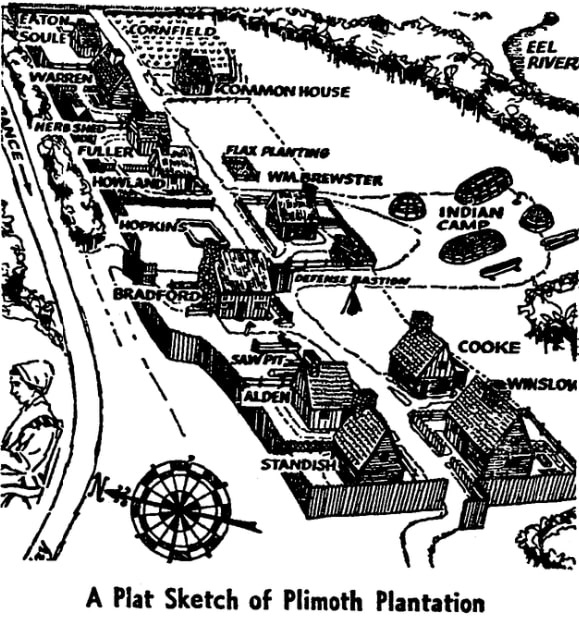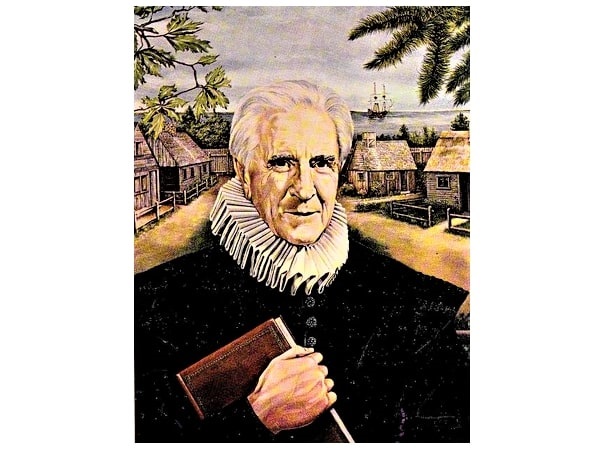Introduction: In this article, Melissa Davenport Berry continues her series profiling descendants of the Mayflower settlers, focusing on former lieutenant governor and president of the Massachusetts Mayflower Society Dr. Rev. Robert Merrill Bartlett of Plymouth, Massachusetts. Melissa is a genealogist who has a blog, AnceStory Archives, and a Facebook group, New England Family Genealogy and History.
Today I continue with my “Mayflower Descendants: Who’s Who” series, focusing on former lieutenant governor and president of the Massachusetts Mayflower Society Dr. Rev. Robert Merrill Bartlett (1898-1995) of Plymouth, Massachusetts, and Naples, Florida.

Rev. Bartlett was 10th in descent from Mayflower passenger Robert Bartlett, who married Mary Warren, daughter of Mayflower passenger Richard Warren Also noted below are other Mayflower passengers in Rev. Bartlett’s ancestral line.
Lineage:
- Rev. Robert Merrill Bartlett and Theresa Susan “Sue” Nuckols
- Robert Alexander Bartlett and Minnie Lou Dobson
- Alexander Bartlett and Laura Salome Merrill
- Isiah Bartlett and Miriam Mason
- Sylvanias Bartlett and Sarah Loring
- Sylvanias Bartlett and Martha Waite
- Joseph Bartlett and Elizabeth Bartlett, daughter of Samuel Bartlett Jr. and Hannah Pabodie, granddaughter of Samuel Bartlett and Sarah Brewster, granddaughter of Robert Bartlett and William Brewster. Hannah Pabodie, daughter of William Pabodie and Elizabeth Alden, granddaughter of John Alden and Priscilla Mullins.
- Joseph Bartlett and Lydia Griswold Holmes
- Joseph Bartlett and Hannah Pope
- Robert Bartlett and Mary Warren
- Robert Bartlett and Alice Walker
Rev. Bartlett dedicated his life and work to preserving Mayflower history as well as debunking the myths and misconceptions surrounding the Pilgrims. He lectured and published extensively on all things Plymouth. He and his wife Sue resided in the Pilgrim house built in 1660 by his ancestor Robert Bartlett, located on Brook Road in Manomet, Massachusetts. Unfortunately, the house was destroyed by fire in 2005.
According to the Patriot Ledger, Rev. Bartlett found a treasure trove of old documents in the attic of the Bartlett family seat.
One document referenced a sexy scandal to squash the opinions of many – namely that the Pilgrims were not prudes! In fact, if you visit the Plymouth town records you will find some racy misbehavior like the following:
“James Clarke complaineth against Sarah Barlow and Marcye Bartlett in an action of slander and defamation, to the damage of two hundred pounds for reporting that they saw said Clarke kiss his mayde and use other [uncivil] carriages that he acted towards her in the field upon the Lord’s day.”
–From Plymouth town records of Oct. 25, 1668
As this newspaper article reports:
“Robert Bartlett found the original record of this small scandal in his attic, hidden among letters and newspaper clippings in a dusty, leatherbound box that yielded a number of stories about his Pilgrim ancestors.”
Rev. Bartlett concludes:
“This does not sound like the stern Puritanism so erroneously attributed to the Pilgrims. The girls were scolded for gossiping and levied a small fine to suggest punishment. The fine was not collected. James Clarke suffered public embarrassment (and no doubt a scolding from his wife). And that was that.”
Furthermore, Rev. Bartlett states:
“There are too many misconceptions about the Pilgrims as a cross, crochety, fanatical people. They were never stern, and they had a good sense of humor. And they didn’t wear black, as some have thought, but beautiful bright colors.”
Bartlett insists that “the Pilgrims were a friendly, peace-loving people.” He says:
“One of the happier incidents in history was the Pilgrims’ friendliness with the Wampanoag Indians.”
The Pilgrims signed a peace treaty with the Wampanoag Indians shortly after they arrived in Plymouth. Read more here: Thanksgiving Mayflower Story.
Another article about Plymouth Plantation, published in the Arkansas Gazette and titled “Second Thoughts on a Gallant Group,” also paints a lighter picture of the Pilgrims.
Writer Harriett Aldridge begins by referring to:
“…the Pilgrim folklore ingrained in our minds from childhood. From the scramble of myth, fact and poetic license in textbooks, and mandatory literature, who could escape drawing a mental picture of the Pilgrims as dour, painfully religious, sternly self-righteous creatures intolerant of others.”
But after taking a tour of the reconstructed Plimoth Plantation, then listening to a talk by Dr. Robert M. Bartlett – the same man featured in the newspaper article above – Aldridge gained a different perspective of the Pilgrims.
“[Bartlett], by his gentle affection for the Pilgrims and his extensive knowledge of their lives, helped erase the distorted image of this gallant group during an informal dinner talk.”
Aldridge wrote:
“Dr. Bartlett’s first point was that the Pilgrims were different from their later-arriving neighbors, the Puritans.
“They wore not just black and gray ‘habits’ but gay colored outfits as noted in an inventory – for tax purposes, praise be – of Bradford’s clothing in which are mentioned among other items a red waistcoat and a violet colored cloak. Brewster’s inventory lists ‘1 blue cloth suit, 1 green waistcoat, 1 pair ye green drawers, 1 red cap…’”
Aldridge wrote that Dr. Bartlett also pointed out:
“Plymouth had no witch hunts, made a peace treaty with the Indians which lasted 55 years, and pursued friendship with people of other faiths. (In his journal ‘Of Plimoth Plantation,’ Bradford, the foster son of Robinson and Brewster, reveals that he entertained a Jesuit priest with a fish dinner one Friday evening in his house, and that Standish was an honored member of the Plantation although he never joined the church.) And unlike many of the other little colonies, the Pilgrims paid their debts in full – by 1645 – to the London Merchant Adventurers who had financed the venture.
“Capping the misconceptions is the awesome title of ‘Pilgrim Fathers.’ These were no bearded, old men. When they landed, Soule was 20; Holland, Doty, and Gilbert Winslow were 21; Alden, Eaton, and Hopkins 22; Edward Winslow had reached 25 years; Bradford 31; Carver and Allerton 34; Fuller 35; Standish 36; and Warren was an aged 38! They were, in the words of Dr. Bartlett, more young, adventurous products of the waning Elizabethan era than pallid saints.”
Stay tuned for more on Dr. Rev. Bartlett and the Pilgrims!
Note: An online collection of newspapers, such as GenealogyBank’s Historical Newspaper Archives, is not only a great way to learn about the lives of your ancestors – the old newspaper articles also help you understand American history and the times your ancestors lived in, and the news they talked about and read in their local papers. Do you have a family connection all the way back to the Mayflower Pilgrims?
Related Articles:
- Mayflower Descendants: Who’s Who, Part I
- Mayflower Descendants: Who’s Who, Part II
- Mayflower Descendants: Who’s Who, Part III
- Mayflower Descendants: Who’s Who, Part IV
- Mayflower Descendants: Who’s Who, Part V
- Mayflower Descendants: Who’s Who, Part VI
- Mayflower Descendants: Who’s Who, Part VII
- Mayflower Descendants: Who’s Who, Part VII (conclusion)
- Mayflower Descendants: Who’s Who, Part 8
- Mayflower Descendants: Who’s Who, Part 9
- Mayflower Descendants: Who’s Who, Part 10
- Mayflower Descendants: Who’s Who, Part 11
- Mayflower Descendants: Who’s Who, Part 12
- Mayflower Descendants: Who’s Who, Part 13
- Mayflower Descendants: Who’s Who, Part 13 (conclusion)
